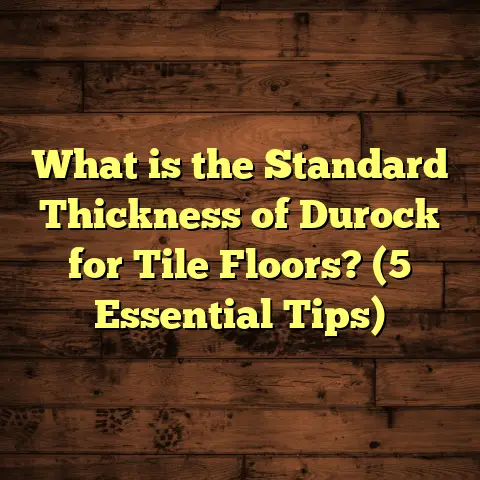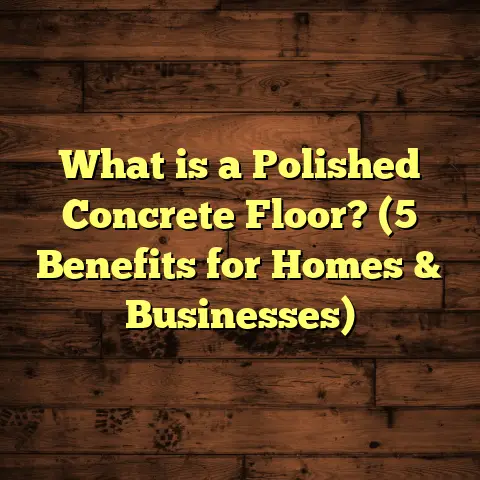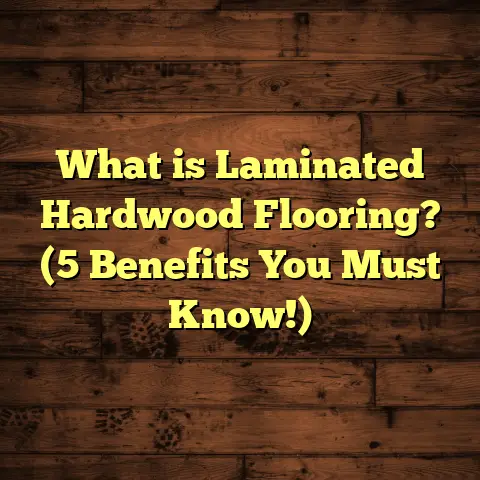What is More Popular: Carpet or Wood Flooring? (5 Key Trends Revealed)
Ease of Maintenance: The Starting Point
You know, when I first started working with flooring, one thing that struck me was how much
people care about ease of maintenance. It’s often the very first question I get: “How easy is
this to clean?” or “Will this hold up if I have kids or pets?” For many homeowners, the
decision between carpet and wood flooring boils down to how much time and effort they’ll need
to keep their floors looking good.
I’ve seen a lot of homes where the floors are the centerpiece, but if they’re hard to maintain,
they quickly lose their charm. So today, I want to share what I’ve learned about carpet versus
wood flooring—what makes each popular, some trends I’ve noticed, and practical tips based
on real-world experience.
What is More Popular: Carpet or Wood Flooring?
When we talk about popularity in flooring, what does that mean exactly? Are we looking at
sales figures, homeowner preferences, or something else? From my experience and the data
I’ve gathered over the years, popularity is a mix of market demand, lifestyle fit, aesthetics,
and regional preferences.
Carpet is a soft floor covering made from woven or tufted fibers such as nylon, polyester,
or wool. It adds warmth and comfort to a room, making it a favorite in bedrooms and living
areas. Carpets come in many styles, colors, and patterns, offering vast design flexibility.
Wood flooring generally refers to solid hardwood or engineered wood planks installed in
rooms to bring in a natural feel. It’s durable and has a timeless appeal that can increase home
value. Wood floors are popular for their aesthetic and versatility, able to fit both rustic and
modern designs.
So which one do people choose more? The answer isn’t simple because it depends on lifestyle,
budget, and even climate. But through some key trends I’ve tracked, we can get a pretty clear
picture.
Trend 1: The Rise of Wood Flooring in Urban Areas
In my work with clients living in cities or newly built homes, I’ve noticed wood floors are
increasingly preferred. Why? Urban homes often have smaller spaces that benefit from the
clean, open look wood provides. Wood floors reflect more light than carpets, making rooms
feel larger and airier.
Here’s some data I found from industry reports:
- Over 65% of new home buyers in metropolitan areas opt for wood or engineered wood flooring.
- A survey by the National Wood Flooring Association showed a 12% increase in wood flooring installations between 2018 and 2023.
One client told me she chose white oak planks for her downtown condo because she wanted
something sleek that would last and be easy to maintain. She said vacuuming hardwood was
way simpler than battling pet hair with carpet.
I remember another project in a high-rise apartment where the homeowners were concerned
about allergens. They swapped out carpet plans entirely for wood floors paired with area rugs
for comfort. This change helped reduce dust accumulation—a big plus for their asthma issues.
Trend 2: Carpet Holds Strong in Comfort and Budget
On the flip side, carpet remains a strong contender—especially in suburban and rural homes
where comfort is king. I’ve worked on many projects where families with kids or elderly members
preferred carpet for its softness underfoot and noise-dampening qualities.
Carpet also tends to be more budget-friendly upfront than wood flooring. According to data
from FloorTally, the average installed cost for mid-range carpet is about $3-$5 per square foot,
while solid hardwood can run $8-$12 or more depending on species.
A personal story: I installed wall-to-wall carpet for a family with three young children. They loved
how it cushioned their kids’ playtime and kept noise down between floors. Plus, the carpet color
was kid-friendly—dark enough to hide stains but still brightened up the room.
What’s interesting is how carpet styles have evolved too. Modern carpets come with stain-resistant
fibers that make cleaning easier than ever before. When I started, spills meant panic; now, a quick
wipe often does the trick.
Also, many homeowners choose carpets with high-density padding underneath for extra comfort—
a feature that older carpets didn’t always have.
Trend 3: Eco-Friendly Choices Shape Flooring Popularity
Sustainability has become a big factor in flooring choices lately. People ask me whether carpets
are recyclable or if wood comes from sustainable forests.
Wood flooring often wins here because it’s a natural product that can last decades. Engineered wood
options can reduce waste because they use less solid wood overall. Some manufacturers offer FSC-certified
products ensuring the wood is responsibly harvested.
Carpet’s environmental impact varies widely depending on material. Nylon carpets are less eco-friendly due
to synthetic components, but newer options like wool or recycled fiber carpets are gaining ground.
From my projects, homeowners interested in green living tend to pick wood floors with low-VOC finishes or natural fiber carpets. It’s fascinating seeing how this concern shapes decisions.
I remember helping a family select bamboo flooring—a type of rapidly renewable wood—for their kitchen remodel. They wanted something sustainable yet durable enough for heavy cooking traffic. Bamboo fit the bill perfectly.
Trend 4: Maintenance Realities Influence Choices
Maintenance really makes a difference in what stays popular over time. I always tell clients that no matter how beautiful a floor is, if it’s a hassle to clean, they’ll regret it eventually.
Wood floors generally require sweeping or vacuuming regularly and occasional refinishing every few years. Spills need quick attention to avoid stains or warping.
Carpets can trap dust and allergens but are better at hiding dirt between cleanings. Regular vacuuming and professional deep cleaning are essential to keep them fresh.
One tip from my experience: If you have pets prone to accidents or lots of foot traffic, wood might be easier to manage long term. But if you want warmth and softness without daily cleaning fuss, carpet is your friend.
For example, a friend of mine who has two dogs told me she regrets choosing light-colored carpet because it shows dirt quickly. She now recommends darker carpets or hard floors for anyone with pets.
Trend 5: Technology and Design Innovations Impact Popularity
New technology has blurred the lines between carpet and wood flooring options. For example:
- Waterproof laminate and vinyl planks mimic wood but resist scratches and water damage better than traditional hardwood.
- Stain-resistant carpets with protective coatings make cleanup easier than ever before.
These innovations mean homeowners can get the look they want without as many compromises on durability or upkeep.
For example, I recently installed a luxury vinyl plank floor for a client who wanted a wood look but needed something tougher due to kids and pets. It looked fantastic and was super easy to clean—a win-win.
There are also carpets now made from recycled plastics that offer durability combined with eco-consciousness—a trend catching on fast among environmentally aware customers.
How Cost Plays Into Popularity
People often ask me about costs—what’s cheaper overall? Carpet usually costs less initially but might need replacing sooner than wood floors, which can last decades when properly cared for.
Using FloorTally has been handy for me when estimating project budgets. It helps calculate local labor rates, material costs, installation time estimates, and even waste factors on one platform instead of juggling multiple quotes or spreadsheets.
For instance, I recently used it for a mid-sized home renovation project where clients were comparing hardwood oak versus nylon carpet. The tool showed that although hardwood installation was pricier upfront by roughly 40%, its durability meant fewer replacements over 20 years—making it more cost-effective long term.
That kind of insight is priceless when advising clients who want both style and smart spending.
Personal Experiences That Shaped My Flooring Perspective
Over the years, I’ve installed thousands of square feet of both carpet and wood flooring across different homes and regions. These experiences gave me unique insights beyond what numbers can show.
For example:
- In colder climates like Minnesota, many clients prefer carpet because it offers insulation against chilly floors during winter months.
- In warmer places like California or Florida, wood floors are more common due to cooling properties and easier cleaning.
- Some families combine both by having hardwood in main areas and carpet in bedrooms or playrooms — balancing aesthetics with comfort.
- Pet owners often lean toward wood for ease of cleaning but add area rugs strategically for softness where their pets rest most.
- Renovators appreciate engineered hardwood because it adapts well over concrete slabs common in basements or condos where solid hardwood isn’t ideal.
One memorable project was for an elderly couple who wanted safety features incorporated into their floors. We installed low-pile carpet in bedrooms to reduce fall risks but put hardwood in hallways for durability. Their feedback after six months was overwhelmingly positive—they loved how each floor matched their needs perfectly.
Data You Should Know About Carpet vs Wood Flooring
Here are some interesting numbers I’ve gathered from reliable sources:
- The Home Improvement Research Institute reports that wood flooring accounted for about 35% of all new flooring sales in 2023.
- Carpets made up roughly 30%, with vinyl and laminate making up the rest.
- Hardwood flooring resale value adds approximately 1-2% to overall home value according to Zillow studies.
- Around 40% of homeowners say maintenance concerns heavily influenced their flooring choice (NAHB survey).
- Allergy sufferers make up about 20% of carpet buyers who prefer hypoallergenic materials (American Lung Association statistics).
How Regional Preferences Affect Flooring Popularity
Where you live makes a big difference in what floors are popular.
In the Northeast and Midwest U.S., carpets still dominate many residential spaces due to cold winters and tradition. Thick carpets help keep homes warm and reduce noise during snow seasons.
In contrast, the West Coast favors hardwoods or vinyl planks that mimic wood because mild climates don’t demand as much insulation from floors. Plus, modern design trends lean toward open spaces with sleek finishes common with wood floors.
In the South, humidity affects choices too—engineered wood performs better than solid hardwood there due to moisture resistance. Carpet remains popular in bedrooms but less so in kitchens or entryways where moisture is an issue.
The Role of Interior Design Trends
Design trends impact popularity as well. Minimalist styles favor clean-lined hardwood floors over textured carpets. Scandinavian-inspired interiors embrace light woods paired with neutral rugs rather than full carpeting.
On the other hand, cozy farmhouse styles often mix wide-plank woods with plush carpets layered on top for warmth and texture contrast—a combination I recommend frequently.
Vintage looks bring back patterned carpets or oriental rugs on top of hardwood floors—adding personality without sacrificing durability beneath.
How Family Dynamics Influence Flooring Choices
I’ve noticed family makeup plays a huge role too:
- Families with toddlers often choose carpets in play areas for safety reasons.
- Teens might prefer hardwoods they can wipe clean after sports gear messes.
- Multi-generational homes sometimes combine both types on different floors based on occupant needs.
- Single adults lean towards easy-maintenance wood floors more frequently because they clean less often but want stylish spaces.
One client had three kids under six plus two dogs—they picked stain-resistant carpet downstairs with hardwood upstairs where noise is less intense. It was a perfect compromise considering their hectic lives.
Common Flooring Problems & How They Affect Popularity
Both carpet and wood flooring come with challenges:
- Carpets can stain easily if not treated promptly; they also wear down quicker in high traffic zones.
- Wood floors scratch but can be refinished multiple times; however water spills can cause warping if ignored.
- Pet claws damage both types but more visibly on hardwood.
- Allergies react differently—some people find carpets trap dust; others find certain woods cause respiratory irritation due to finishes used.
Knowing these issues helps homeowners make informed choices tailored to their lifestyle rather than just aesthetics or price alone.
Tips for Choosing Between Carpet and Wood Flooring
I want to share some tips based on decades of experience that can help you decide:
1) Evaluate Daily Use
Think about how you use your space daily. Do you want soft landing spots? Or do you want something easy to sweep after cooking?
2) Check for Allergies
Ask if anyone has allergies—wood floors paired with washable rugs might be best if allergies are severe.
3) Consider Pets & Kids
If you have kids or pets prone to spills/scratches choose durable finishes or stain-resistant carpet fibers accordingly.
4) Budget Wisely
Don’t just focus on upfront cost; consider long-term replacement cycles and maintenance expenses too.
5) Sample Before Buying
Bring samples home — lighting affects appearance dramatically!
6) Use Estimation Tools
Tools like FloorTally have helped me provide accurate quotes fast by integrating labor/material costs localized by zip code—saving guesswork on budgets.
Final Thoughts Based on Experience
When someone asks me “What should I pick—carpet or wood?” I usually respond with questions about their lifestyle rather than just preferences alone.
If you crave warmth underfoot with lots of noise absorption—and your budget leans modest—carpet may be right for you.
If you prefer timeless style combined with durability that adds resale value—and can invest a bit more—the beauty of wood floors is hard to beat.
And remember: mixing both can create balanced homes that cater perfectly to comfort AND practicality!
If you want advice on specific brands, installation techniques, or care tips for your selected flooring type, just ask—I’m always happy to share what works best based on real-world projects I’ve done!
(End of article)





